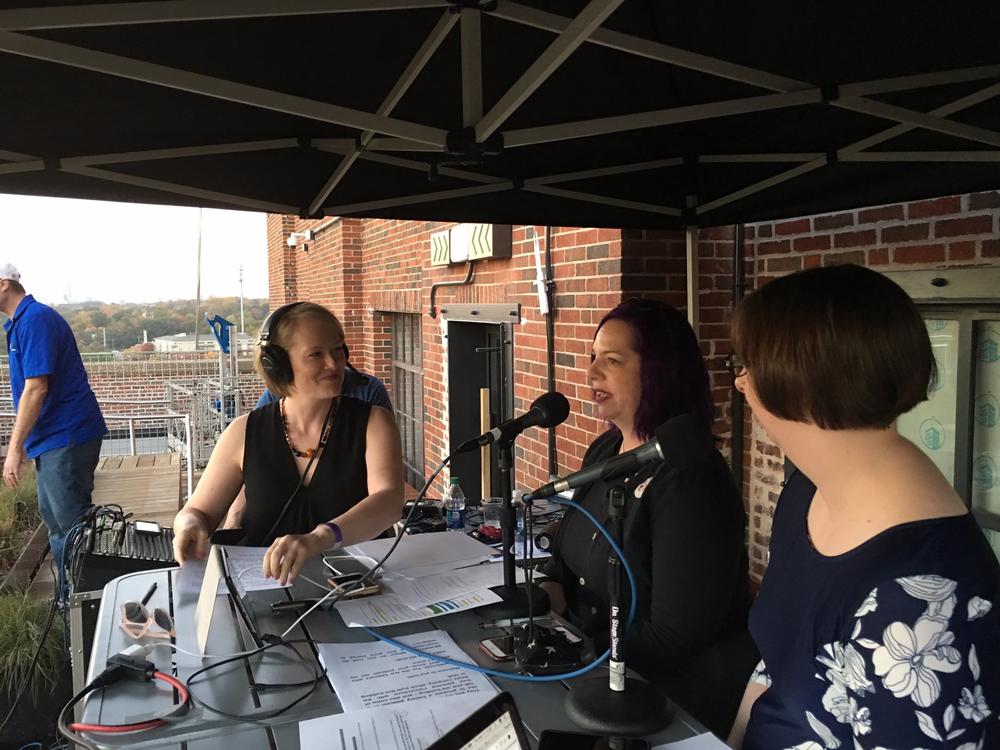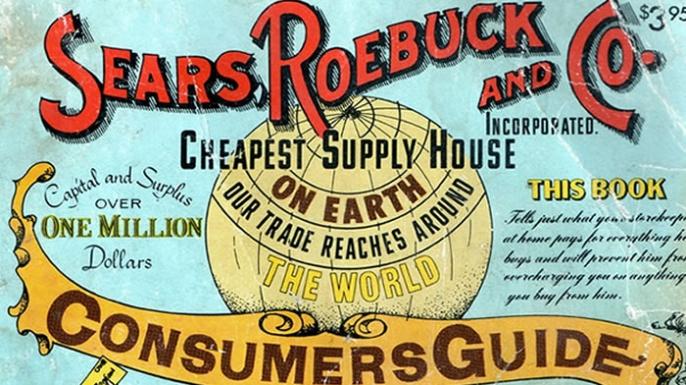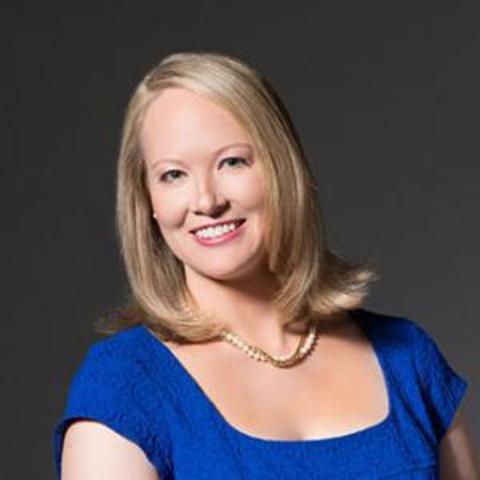Section Branding
Header Content
Fine Art At Sears, And Other 'Stuff You Missed In History Class'
Primary Content
Tracy V. Wilson and Holly Frey host the popular podcast Stuff You Missed In History Class in the Atlanta offices at HowStuffWorks at Ponce City Market.
They joined me during our live show from the rooftop of Ponce City Market to talk about what it’s like to produce a history podcast in a historic building – and also some of their personal connections with the Sears company, which built this building in 1926.
Rickey Bevington: So for the few listeners very few who may not know your podcast, just tell us tell us about the program.
Tracy V. Wilson: So we talk about history that's been overlooked in some way. A lot of times it's things that have been overlooked because maybe they might seem insignificant or silly, like the history of sewing machines, but in reality that was really important. It completely changed the way people made their own clothing. It changed the lives of women who had a lot more time to do other things around the house.
Holly Frey: It also changed patent law.
Wilson: Big changes to patent law! And then we also talk about things that that might also be overlooked but are really important.
So we for example have a whole series we've collected over the years of episodes that connects the dots between slavery and today and how like that wasn't slavery and then nothing. And Jim Crow and nothing and today there's a whole series of events that connects all of that together.
Bevington: And I should mention for listeners, what you're hearing in the background of course is a very rowdy midway at happy hour, so people are playing mini golf, and Horse Derby. I think skeeball is getting particularly rowdy right now.
It's a really good time on the roof of Ponce City Market. So where do you look for inspiration and find great stories and research?
Frey: Absolutely everywhere. Nothing is off limits. Inspiration comes from all over the place.
One of the things that I really loved researching for our show – and as one of my favorite set of episodes still – (I'm a big Disney nerd and I super love the Haunted Mansion). We did a two-part episode about how the Haunted Mansion was developed, and it's one of those stories that it literally spans decades.
And it seems like a weird thing maybe to talk about, but people then realize Disney was not always this moneyed juggernaut and there were times they struggled, and they had the same kind of problems that you have today. If you're on a big project at work and it drags out, and people fight, and there's all kinds of drama like that, it happens all the time.
Similarly, we recently filmed some footage at NASA's Goddard Space Flight Center, and while we were there Charles Bolden (who is the administrator of NASA) was talking about how no one knows that much about James Webb. It’s who the James Webb Space Telescope is named after.
So, I'm happy to say we have an upcoming episode about him and the Apollo program and how that all fits into the bigger history of the United States, and really, the globe.
Bevington: So how do you narrow it down if every everything is a source of inspiration?
Wilson: Lately what’s been narrowing it down is the current political climate in the United States. Post-election, it seems like every other day there is a comment that suddenly becomes a headline that relates to something in history that we've been talking about and we go “OK, that's going up to the top of the list now.”
Frey: You know, the list is has bubbled in very exciting ways in recent weeks.
Bevington: Can you maybe give us a little political preview?
Wilson: Well we've talked for a long time about wanting to have an episode about the internment camps during World War II. And with that recently being held up as a precedent for a Muslim registration list, that's where you kind of want to dive into what that was actually about. And so that's been on the list for a long time.
But it's higher on the list than it was last week.
Frey: Yeah it just rocketed to the top couple of spots.
Bevington: So how long have you been doing this podcast together as a team?
Wilson: We're Coming up on four years.
Bevington: You guys have great energy and dynamic. Did you know each other before hand?
Frey: Yes we did. We actually started podcasting, because we were at a party and we had been doing other jobs at HowStuffWorks. And our boss heard us being snarky at a party and said “I think you guys should have a podcast together.”
Wilson: And then we did. It was a different podcast from this one but yeah.
Bevington: So your podcast is produced right here in Ponce City Market, and this building has its own incredible history. It was once the Southeastern headquarters for Sears Roebuck. It served as a warehouse in a show room of agricultural farming products for thousands of farmers across Georgia and really across the south.
It was the Southeastern hub and the railroad hub for Sears that they would bring in all the stuff.
So what can you tell me about the era? What was going on in America in 1926 when Sears decides to build this massive warehouse?
00:04:51
Wilson: They got the property in 1925 and then in 1926 the building was actually dedicated. So we have the roaring 20s going on at that point. Prohibition is really in full swing. In 1925, that was the first year that the Grand Ole Opry was broadcast and then the following year, 1926 to Ford Bailey who we've talked about on the show before we talked about harmonicas. He was the first black man to perform on the Grand Ole Opry. 1926 was also the first year that Winnie the Pooh existed as a book it was published for the first time. Houdini also died that year which is a little sad right at the same time like that within those couple of years.
There were a lot of things that we remember a lot today like The Great Gatsby, which is just such a hallmark of that time period, it came out in 1925. The Nome Serum run, which we have talked about on the podcast, which was the lifesaving delivery by sled dog of diphtheria serum. You know, that that happened in 1925 sort of as the building was being built in here.
Bevington: This location: it wasn't the first time people had been coming to this particular part of metro Atlanta?
Wilson: A man named Dr. Henry L. Wilson nicknamed the Ponce Springs after Ponce de Leon, who was searching for the fountain of youth. And so they had the whole idea was this spring water would heal people's sicknesses. And so he named it after Ponce. We’re not saying his name the way he actually said it.
And yet this is the way people pronounce Ponce de Leon today in Atlanta, and then after that it was an amusement park and then a baseball field and then Sears bought the property and built this building.
Bevington: And Tracy, I understand that your family actually has a personal connection with yours.
Wilson: My grandmother worked at Sears for as long as I can remember. She actually retired from Sears in 1983 which was the year that Cabbage Patch dolls were the thing to get. People were literally knocking each other down to get them.
She used her power of being a Sears employee to secret one away for me to have as my Christmas present. And it is one of my fondest memories of my grandmother who passed away in 2006. And whenever I walk into the building on the Ponce side where it has the Sears and Roebuck carving in the wall I'm reminded of my grandmother.
And what a great memory that was.
Bevington: And you bought them through the Sears catalog.
Frey: The Sears catalog is sort of an interesting story in and of itself and it's really sort of the story of America and consumerism.
It was first published in 1888 which was kind of an interesting time because the Homestead Act of 1862 had kind of encouraged people to move west, and go into places where they were not retail hubs.
So they needed something that they could access and to have shipped to them. There were also some interesting things going on with the postal service where they, you know, sort of made some provisions for bulk mailings to be really economical, so it made it really great for catalogues that they could distribute to a wider market.
And what's really interesting is some of the slogans that Richard Sears would come up with for his catalog because he really wanted to pitch like that this is an important sort of homegrown part of America.
Some of them were called like “The Book of Bargains: A Money Saver for Everyone.” Like they would have their own little kooky titles. “The cheapest supply house on Earth” was one of their subtitles for Sears during the catalog era.
Our trade reaches around the world because they were, again, in addition to bulk mailings the ability to ship things further and further it was developing.
And then one of my favorites is “We can't afford to lose the customer,” like they were kind of suggesting that the catalog industry was kind of you know one where they didn't have huge margins so they needed every one of you to buy in and really be a part of the Sears story.
And eventually of course, it started out just selling watches and jewelry. But it expanded to include things like clothing and farm equipment and even buggies. And in many ways this really parallels the modern experience.
Industries like Amazon started developing and other online shopping options. There was such a furor over the loss of brick and mortar stores but in fact really the large scale consumer market initiated in the U.S. as a shift to your home model which is kind of a fascinating thing and what I really love is that the Sears company was kind of shockingly self-aware that they were representing what the U.S. was during any given time it was being published.
And in 1943 their company newspaper which was called the Sears news graphic printed this note in the catalog that said that the catalog “serves as a mirror of our times recording for future historians today's desires, habits, customs, and mode of living,” which is shockingly self-aware for a retailer.
But then we get into one of my favorite parts of Sears history, and it was not so much part of the catalog but they had a really amazing art program that Vincent Price curated for them where you can buy original works of art through Sears.
Bevington: It wasn't just original works of art, we're talking real art.
Frey: They were the original pieces that he and his wife Mary at the time would travel around the world all the time for work but also to look for art collections and buy originals everything from you know a Picasso to a Dali. Everything in between the great masters. Some things were smaller like etchings versus like the paintings that went for much more but you could walk into your local Sears. In some cases you could walk into your local Sears and meet Vincent Price and purchased a piece of art directly from you.
Bevington: So just for the audience who just caught the end of it, you used to be able to buy a Picasso at Sears.
Frey: Yeah it's really fascinating and kind of brain bending thing to consider it.
Bevington: So you recently had a podcast where you featured the daughter of Vincent Price –who, by the way, for anybody who might be too young to remember Vincent Price – This breaks my heart to have to explain that he is a great actor.
Victoria Price actually talked about this aspect of her of her parents’ work when she was little. And we also have an audio clip from your podcast. So let's hear Victoria price discussing Vincent Price work with art in Sears.
Bevington: So, you guys don't call yourselves historians, Even though we just heard a long explanation of the Sears catalog, and an incredible amount of history in the last 10 minutes of this conversation. Why are you not historians?
Wilson: Well, so I have a dear friend named Amy who is actually a history teacher here in Atlanta who insists that we are historians because of the care and approach that we take in what we're doing.
But neither of us has a degree in history. My degree is in literature although I went to the University of North Carolina at Asheville, which has a very large humanities program as part of its core graduation requirements. And it was really studying humanities that I realized I loved history and I loved looking at history through art, and through literature, and through all the different things that add up together to be a worldview. And that has really informed how I work on this show.
Holly, your degree is in theater and film studies.
Frey: And I also studied English romantic literature, which both touch on history but are not particularly history focused. If you had asked me even eight years ago, I would have told you I did not particularly care for history. It wasn't really until I had this revelation, because I was working in a library and I was doing acquisitions and I kept ordering books and my boss pointed out you order a lot of historical clothing books and I was like “Oh! That's my in!” and it was just the schooling angle of it wasn't what appealed to me. But being able to explore it through that lens of culture was really fascinating.



